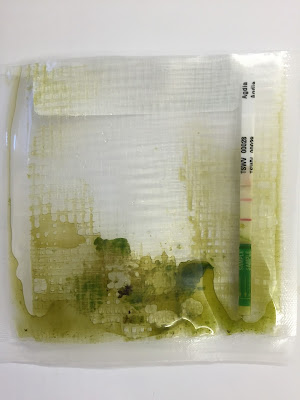 |
Chile plant exhibiting symptoms of Tomato
Spotted Wilt Virus (Photo: NMSU - PDC) |
We've highlighted this disease before, but it's such an interesting disease that we decided to do it again! This chile plant was submitted for disease analysis exhibiting classic symptoms of Tomato Spotted Wilt Virus (TSWV). Symptoms of TSWV can be quite variable, but some of the more common symptoms include leaf deformity (especially of the new growth), terminal necrosis, leaf drooping (wilt-like appearance), stunting, mottling, and spotting (necrotic and chlorotic). In this particular case, several leaves on the plant displayed characteristic chlorotic spots with concentric rings (see images below). Fruit symptoms can also be quite striking. Fruit symptoms include: chlorotic concentric ringspots, raised bumps, uneven ripening and deformity. Plants infected early in the season may produce little or no fruit. In this case, the plant produced only one small, deformed fruit which ripened prematurely. Most viral diseases are confirmed using some form of DNA analysis. In this case, there is an antibody-antigen test that can detect the virus in just a few minutes. A small amount of plant tissue is ground in buffer and then a strip embedded with antibodies to the virus is placed in the sap solution. If the virus is present, two purple lines appear on the strip (if only one line appears, it indicates that the test worked, but the virus was not present). Below is a photo of the antibody-antigen test for this plant.
 |
Terminal leaf deformity caused by Tomato Spotted
Wilt Virus (Photo: NMSU-PDC) |
 |
Chile pepper leaves exhibiting chlorotic concentric ringspots characteristic
of TSWV (Photo: NMSU-PDC) |
 |
Antibody-antigen test results for Tomato Spotted Wilt Virus -
two purple lines indicated that the tissue is infected
with Tomato Spotted Wilt Virus (Photo: NMSU-PDC) |





No comments:
Post a Comment